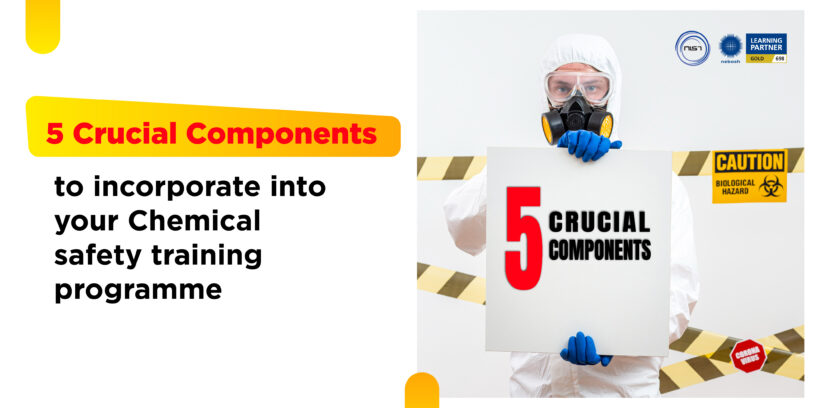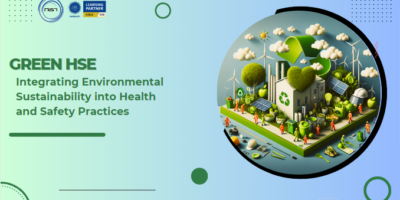Employers are required to inform workers of the health concerns and risks associated with chemical exposure. The duty does not, however, cease with hazard communication. Strong chemical safety training programmes are also required to manage chemical hazards.
This blog post explains 5 crucial components to incorporate into your safety training programme to make sure that your employees are aware of the potential effects chemicals may have on their health and wellness as well as how to handle and use them safely.
1. Chemical hazard awareness
Your training programme on chemical safety should start by assisting employees and contractors in comprehending the chemical characteristics of the products and substances they operate with.
- Your training should go through each person’s responsibilities in addition to the actual risks of chemical exposure.
- The personnel should be aware of all the physical and health risks posed by the chemicals by the end of the session, as well as how those risks might affect their own safety and health.
- How to read safety data sheets (SDSs), chemical labels, and placards to quickly
- Identify information on risks, personal protective equipment (PPE), handling, first aid, and emergency procedures.
- Which materials and substances are incompatible with the chemicals being used and what type of dangerous reactions could occur.
- Specific handling and storage measures required by legislation
2. Safety control measures including PPE
Additionally, workers need to have a thorough understanding of each item of safety gear they will be required to use or wear. The training ought to cover:
- Choosing the appropriate PPE for the task (eg, using thermal protection gloves vs cotton gloves when changing LPG cylinders).
- The significance of properly fitting PPE (e.g., never lend or borrow PPE; chemical goggles that are too loose could allow corrosive chemicals to spray into their eyes).
- How to correctly use PPE, such as layering a fully enclosed chemical suit with gloves, boots, and face protection.
- Cleaning their own PPE (eg, laundering protective clothing after a chemical spill).
- When to change PPE (eg, with repeated immersion in chemicals, gloves will eventually deteriorate).
- Where to keep PPE and why security is so important (eg, keeping PPE in a dedicated cabinet to protect it from dust, theft, moisture, vermin).
3. Chemical Storage Instructions
Use your imagination to make the training session on storing chemical containers and not leaving them uncapped on workbenches sound significant and desirable rather than like a nag session. You might motivate your workers to do it well by using actual examples as the material is straightforward. Following are some suggestions:
- Recapping containers
- Restraining gas cylinders
- Using a compatible spill response kit
- Labelling portable containers
4. Responding to a chemical emergency
It is crucial to divide staff preparation for a chemical emergency into three distinct areas:
- Personal emergency training is centred on a chemical incident, accident, or emergency that directly affects the worker, such as when caustic chemicals spill on their clothing and seep into their boots and gloves. Employees must receive training on how to use first aid supplies, safety showers, and eyewash stations, as well as how to alert managers, supervisors, and emergency services.
- Responding to a workplace accident or chemical situation where another employee has been hurt. It might be in their own workspace or another location on the construction site. The training will emphasise alerting and collaborating with emergency responders in addition to utilising emergency equipment (showers, eye-wash, etc.) to provide first aid to a co-worker or contractor.
- Worker responsibilities in a chemical emergency that impacts a sizable region or the entire site. Drills for emergency response, fire protection, and evacuation are included in this type of training. Employees may be required to shut down working equipment and plant using emergency PPE (breathing apparatus). All of this ought to be covered in the instruction.
5. Chemical spill response
Finally, your team should be aware of what to do in the event of a spill or unintentional chemical release. The following topics ought to be covered during the session:
- Risks of exposure and immediate danger to the environment, the workplace, the property, and the health of employees and visitors.
- PPE to wear while around a spill.
- The containment and isolation of the spill location (including signage).
- Notifying management and supervisors.
- Cleaning up the spill safely.
- Removing damaged containers and used chemical waste.
Chemical safety training is considered to be an essential administrative control that is part of a compliant risk management plan. We recommend Chemical Safety Training from NIST, India’s No1 Safety Organization. We also offer NEBOSH Process Safety Management Training which will also emphasize on the topic Chemical safety and it is one of the top international safety courses that is recognized by global employers. We have certified experts who deliver world-class online virtual sessions & in-person training far beyond excellence.
For further details about customized Chemical Safety Training / NEBOSH Process Safety Management course, kindly call +91 8056000530 / info@nistglobal.com













Leave a Reply